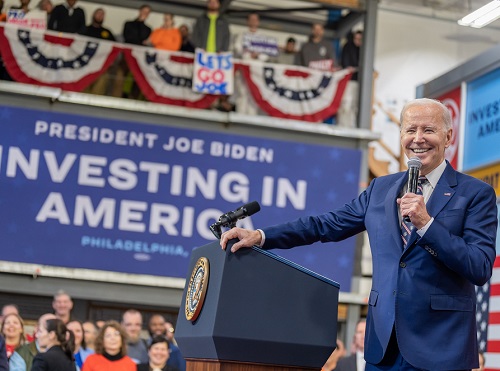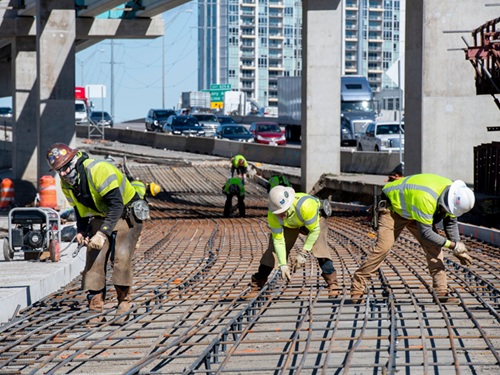The $6.9 trillion fiscal year 2024 budget proposal unveiled March 9 by President Biden (above) provides a total of $114.9 billion in budget authority and obligation limitations to the U.S. Department of Transportation.
[Above Official White House Photo by Adam Schultz]
The main highlight of the President’s FY 2024 budget request, according to analysis by the American Association of State Highway and Transportation Officials, is that funding levels authorized under the $1.2 trillion Infrastructure Investment and Jobs Act or IIJA – enacted in November 2021 – continue unimpeded, with $80.3 billion provided via contract authority for trust fund programs and $36.8 billion in advance appropriations.

Concurrently, the administration is requesting $27.8 billion in discretionary budget authority from the General Fund, which is traditionally where Congressional appropriators focus on as part of the Transportation-Housing and Urban Development or THUD annual funding package.
Specifically, AASHTO said the Biden administration seeks to cut out Congressional earmarks and zeroes out certain General Fund supplements to the Federal Aviation Administration, Federal Highway Administration, and Federal Transit Administration formula programs that have been the norm in the recent years.
At the same time, the President seeks to ramp up funding for USDOT’s Mega discretionary grants programs, various Federal Railroad Administration programs, and FTA Capital Investment Grants – with a net discretionary funding reduction of $882 million in FY 2024 compared to FY 2023.

The USDOT highlights within the administration’s budget proposal includes a section on the provision of more funds to specific programs via the Inflation Reduction Act, including the Neighborhood Access and Equity Grant Program ($3.2 billion), Low-Carbon Transportation Materials Grants Program ($2 billion), and the Alternative Fuel and Low-Emission Aviation Technology Program ($297 million).
Roadway safety and supply chain funding also figure large in Biden’s budget plan, consistent with the IIJA, including:
- A request for over $1.3 billion for the National Highway Traffic Safety Administration, an increase of $116 million above the FY 2023 enacted level;
- A request for $1.5 billion for the FRA’s Consolidated Rail Infrastructure and Safety Improvements or CRISI grant program, as well as $850 million to fund railway crossing safety projects and $7.5 billion in grants to Amtrak.
- A request for $60 million for the IIJA’s Active Transportation Infrastructure Investment Program, an increase of $15 million from the FY 2023 enacted level, to build safe walking and bicycling facilities that connect people with public transportation, businesses, workplaces, schools, and other communities, all while reducing greenhouse gas emissions;
- A request for $230 million for the Port Infrastructure Development Program to strengthen maritime freight capacity on top of the $450 million in the IIJA for 2024. In addition to keeping the nation’s supply chain moving by improving efficiency, USDOT would prioritize port projects that also lower emission; reducing environmental impact in and around the country’s ports.
In a broad March 9 speech in Philadelphia regarding his FY 2024 funding requests, President Biden touched on what he considered to be key “transportation themes” within his budget proposal.

“How can you lead the world if you have second-rate ports, highways, drinking water, et cetera? Modern infrastructure will not only make us more economically competitive, it’s going to create more benefits, save money for the country and families,” he said.
The president also redoubled his commitment to building that infrastructure with U.S. made materials via strengthened “Buy America, Build America” rules.
“We’re going to be at the beginning of the supply chain, not the end of the supply chain,” Biden stressed. “All the construction materials used in federal infrastructure project can be made in America — lumber, gas, drywall, glass, [and] fiber-optic cables. And on my watch, American roads, bridges, highways — they’re going to be made with American products.”
The president also reinforced his administration’s efforts to electrify the nation’s transportation system – especially through the deployment of more electric vehicles or EVs.
“I gathered together leaders from American automakers on the South Lawn of the White House – all the American manufacturers – two summers ago. And guess what? They all agreed,” he said. “Within the next month, they came to me and said, ‘We’re going to go all electric.’ And that’s going to save billions of gallons of gasoline burning into the air. It’s not only going to save the environment, it’s going to help create really good-paying jobs.”



